10 Common Types of Email Marketing For eCommerce Businesses
Developing an email marketing strategy might be difficult for small business owners. They frequently do not have the time to plan for anything other than announcements and promotions.
But you’ll need a lot more than that to keep your subscribers interested. Ideally, your emails will be something customers look forward to reading, so they will remember your company even if they aren’t ready to buy.
In other words, you should not always send the same kind of emails. In this article, I will share with you the various types of email campaigns you can send to keep your subscribers interested and potentially increase revenues. Let’s jump right into the details!
Why Do You Need To Send Different Types of Emails?
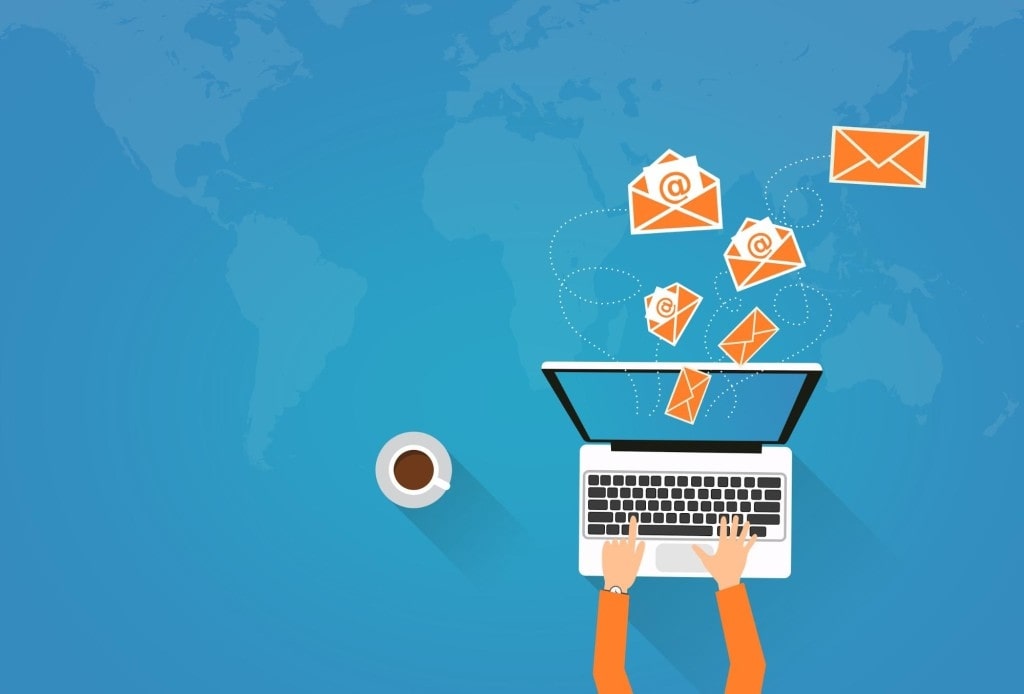
The issue with many poor email marketing strategies is not that they send emails too frequently or too infrequently. It’s because the content they’re sending isn’t distinctive enough. If you keep sending out the same old weekly newsletter, your subscribers will lose interest in your emails before they have an opportunity to convert.
Another issue with poor email marketing efforts is that they do not feature a suitable balance of “value” versus “selling”. If you regularly send one or the other form of email, you will either turn off your readers or never sell anything.
Be open to new experiences. Your audience will appreciate it, and you will profit from improved open and click through rates, which will lead to greater sales. To get you started, let’s go through some of the many types of emails you should be sending to your list:
10 common types of marketing emails you should send
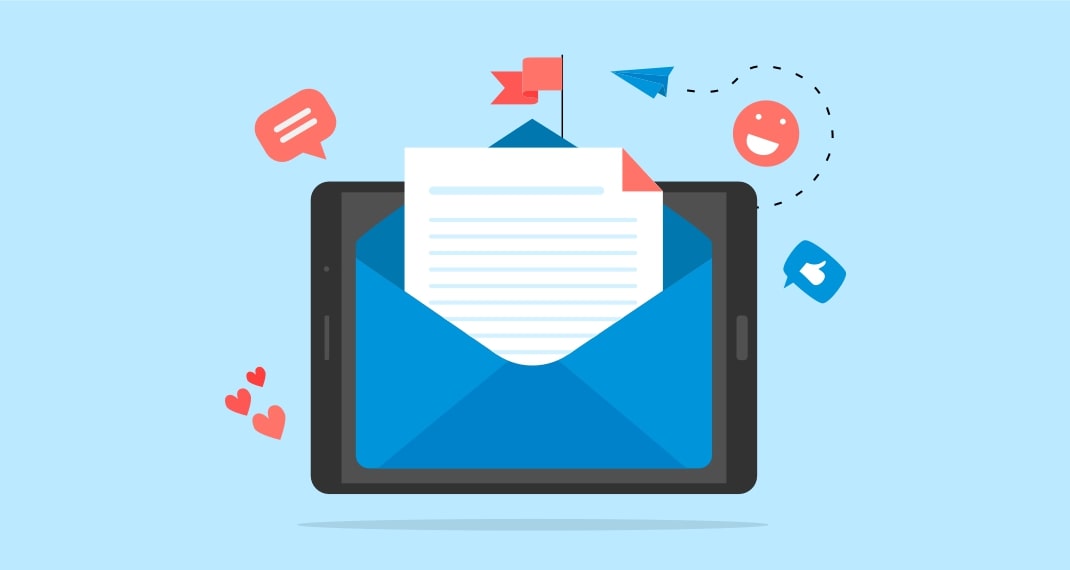
Marketing emails are critical for developing customer relationships, nurturing leads, educating customers, and much more. Let’s take a look at the different types of marketing emails you can send out.
1. Welcome email
A welcome email is an introduction that will help new subscribers navigate your brand. These emails frequently have the highest open rates of any sort of marketing email, so your goal is to capitalize on the heightened attention and expose your brand to new prospects.
Make it clear to your subscribers about your values, essential features, and objectives. You can also provide them with a brief tutorial on how to use your product in video, text, or a link to the knowledge base, or even by scheduling a consultation with your manager.
With their adorable welcome email, Redbubble nailed it. From the start, the brand fosters a joyful and creative environment. Aside from greeting new members, the message informs newcomers on how to use the service, motivates artists to sell their works on the platform, and asks subscribers to peruse popular categories on the website.
This email is visually appealing. Especially the primary image, which immediately makes me grin. With a cheerful and jovial tone of voice, short phrases, and subtle humor in the perfect spots, the copy performs nicely.

2. Newsletter
A newsletter is an excellent choice for businesses that promote their services and goods through content marketing. Multi-topic emails collect the best articles, videos, or podcasts and deliver them to recipients’ inboxes on a regular basis.
The key objective of newsletter email campaigns are to keep in touch with customers on a regular basis and to increase traffic to a website or blog. To achieve these objectives, make your newsletter entertaining, well-structured, visually appealing, and relevant. Let’s grab some ideas from Medium’s daily digest.
Future readers can choose which topics interest them when they subscribe. Medium provides stories to subscribers depending on the categories they choose, their reading history, and the editor’s pick. The many recommendation sources are clearly differentiated, and the email structure is basic, making the newsletter easy to read.
The newsletter is visually appealing because of the eye-catching visuals that accompany each section of the email. To save time while creating the digest, Medium leverages article headers from their website to introduce each piece rather than generating a new description for each digest.
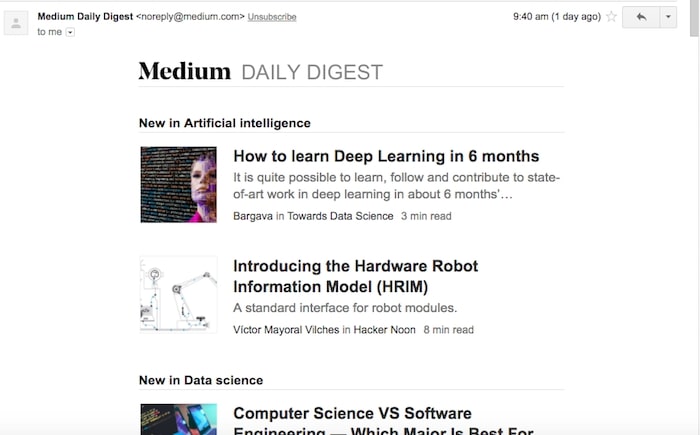
3. Announcement email
Announcement emails provide new products and services, provide updates, or inform customers about planned events. The purpose of announcement emails is to pique people’s interest in something fresh from your company.
To develop an effective announcement email, make it obvious in the subject line and at the top of the email what it’s about. Describe the advantages of whatever your company is announcing. Finish your message with a strong call to action. Finally, be certain that you carefully select your receivers - they should be interested in your proposal. Otherwise, you’ll be inundated with unsubscribe requests rather than new customers.
Figma encourages its customers to try new plugins in the example email below. The corporation limited its promotion to existing customers because they are more familiar with the service and are more likely to use this option.
The email recreates the look of the main website with a sleek and clean design. The content quickly outlines the new feature’s functions and emphasizes its benefits to users. However, there is always opportunity for improvement: the email could be more effective if it included a clear and compelling call to action.

4. Lead nurturing email
Lead nurturing emails are sent to people who haven’t decided whether or not to buy from your company. The primary purpose of these campaigns is to stay in touch with subscribers and inspire them to make a purchase by demonstrating the benefits of your product or service.
To nail this type of email, prioritize the recipients’ interests, wants, and pains. By doing so, you may give valuable material while maximizing the ROI of your campaign. Match the content of each email to where the recipient is in the buyer’s journey. Make the initial message relevant to your leads’ needs by highlighting facts relevant to their wants, then stress the selling component in the subsequent email. Subscribers’ likelihood of making a purchase should increase with every message you send out.
We can see here how Artifact Uprising, a printing business, nurtured their leads. To excite their recipients about the potential value they might obtain from the brand, the brand provides tips on creating appealing picture albums, sharing hacks, and inspiring ideas.
The email has no mention of making a purchase. Instead, it encourages the reader to learn more about the product in a gentle manner. The language may be brief, but Artifact Uprising allows the visual component to speak for itself. This email’s design is eye candy, with a minimalistic design and pastel color palette.

5. Special offer email
A special offer email is one that promotes an appealing discount or offer. These promotions encourage the recipient to make a purchase as quickly as possible.
Give your subscribers a great deal, such as a healthy discount or a gift. Add a time limit to your offer to make it more tempting. Don’t go overboard with the copy; keep it brief yet compelling. Segment your receivers and tailor your emails; if a cat owner receives a discount on dog food, no matter how appealing the offer, they will not buy it.
In the example below, Look Fantastic, a cosmetics store, gives a one-day discount. The brand invests heavily in the aesthetic aspect of its email, employing a colorful color scheme and including eye-catching graphics. The copy emphasizes brand names, special goodies, and savings in large capital letters. That is precisely what this type of email requires.

6. Birthday email
Birthday is a special day for everyone, and brands frequently take advantage of this opportunity to connect with their customers and boost sales. You can use this type of email to offer customers discounts, free goodies, gift suggestions, or advice on how to prepare for a birthday celebration.
This campaign can be sent not just on the subscriber’s special day, but also one or two days in advance. Resend a birthday email after a few days to remind the recipient of your offer to increase the likelihood of a purchase. The visual and copy elements of the content should both convey a joyful vibe.
On their birthdays, Topshop sends their followers a promo code for a 30-day discount. The email begins with a gorgeous collage in vibrant colors to pique the recipients’ interest. This picture is unique in that it does not include cakes, candles, or other birthday clichés. The vibrant color palette and balloons, on the other hand, create a cheerful mood. The CTA-button, however, is difficult to recognize against this background.
The brand eschewed overly sentimental birthday greetings and got right to the point – the discount. This change makes the copy more effective while also saving the reader time.
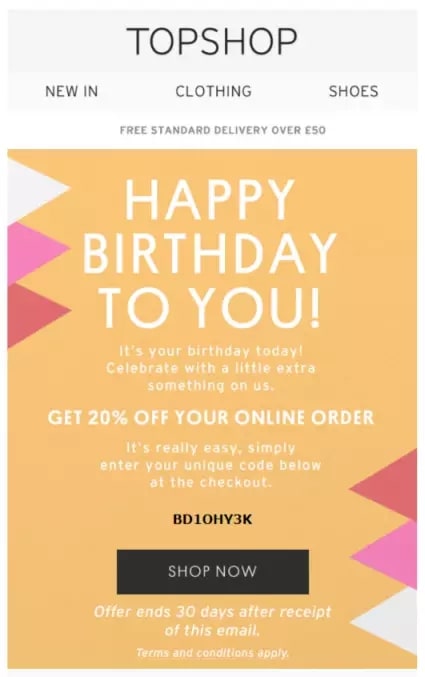
7. Re-engagement email
If your subscribers have not responded to your messages in three months or so, it is time to send them a re-engagement email. This form of email re-engages your subscribers with your brand while also removing inactive subscribers from your mailing list.
To make it work, figure out why your subscribers aren’t reading your emails. If the present frequency of emails from your brand does not satisfy them, give them the choice to modify it. Add social networking buttons for people who like this form of communication. Using text or graphic elements, emphasize your message.
Google Maps used a heartbreaking image of a sorrowful puppy to illustrate their “sadness” at missing a user. This move is somewhat cliche, but it is really effective. The email design is simple and straightforward.
Google stresses community ideals in the copy and encourages users to contribute to their Local Guides platform. However, the service avoids being overbearing. This email also allows users to adjust their preferred mailing frequency or unsubscribe.
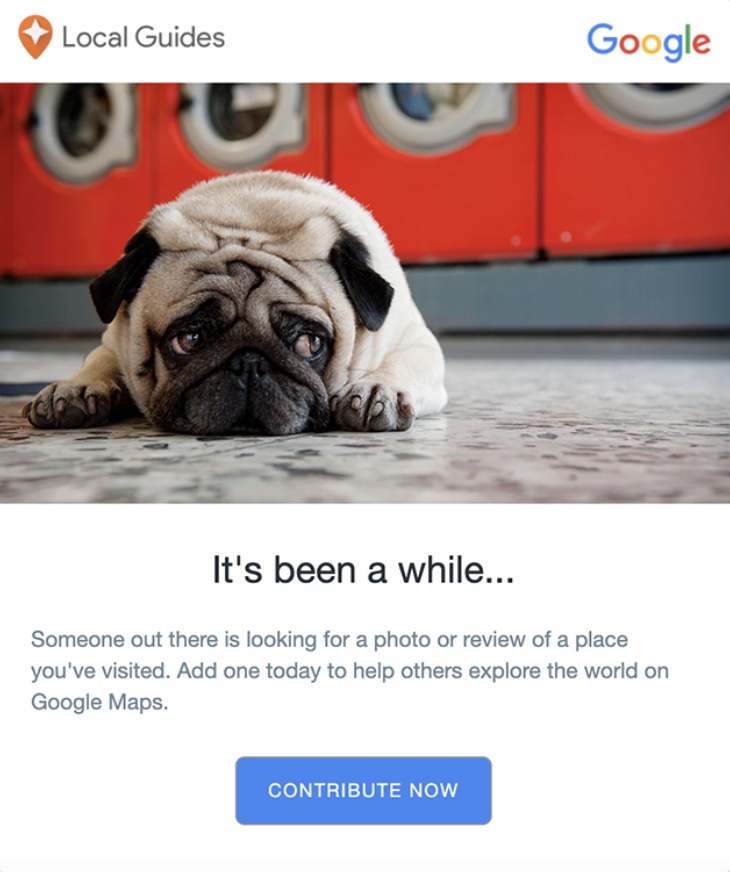
8. Abandoned cart email
Sending abandoned cart emails is an excellent approach to boost your revenue. These messages’ purpose is to remind customers of a purchase they were about to make. Send these emails within 24 hours of your customers abandoning their carts to be most effective. Otherwise, they can forget about their order.
Best practices for abandoned cart emails include including a list of the items in the user’s cart, showing the overall price as well as the price of each item, and including a discount. Remember that the email should be entirely in sync with your brand’s overall tone of voice. Your tone can be formal, concise, or funny, like in the email below from BarkBox.
Almost all of the best practices are nailed down by the monthly subscription service. The email arrives in the mailbox of a user within an hour of them abandoning their cart, details the order, and includes a money-back promise.
The message begins with an animated animation of an adorable dog and continues with a product image, an eye-catching block with a money-back promise, and two prominent CTA buttons. The email is sea-themed and has a soothing blue color palette. The copy supports the marine style by employing idioms deftly. The wording is concise, but it addresses all of the customer’s worries and complaints.
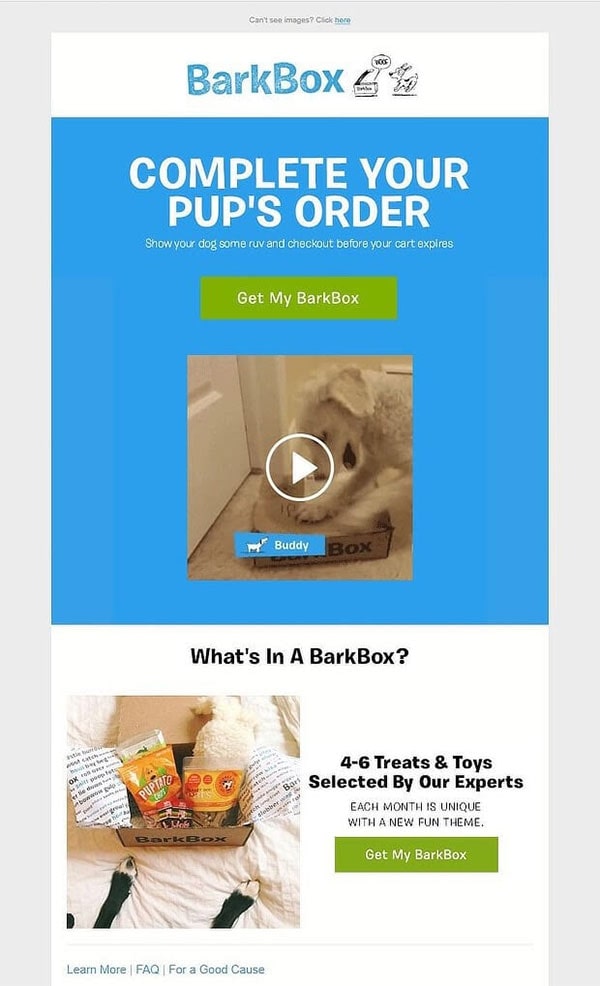
9. Order confirmation email
Following a transaction, it is your responsibility to reassure the customer that everything is in order. Send them an automated order confirmation email as soon as possible. Consider offering recommendations or discounts for future purchases in addition to the order number, tracking code, and specific information about each item.
Take a peek at the ProFlowers example below. The store informs customers about their order, provides delivery information, explains the following stages with stunning infographics, gives discounts, and gives a reminder about when the flowers will be delivered.
The light, airy appearance is ideal for a flower delivery business. The important data — an image of the flower, the delivery address and date, the following steps, and the special offer — stand out, making an email easy to read. The copy is succinct, which is exactly what you need in this situation.
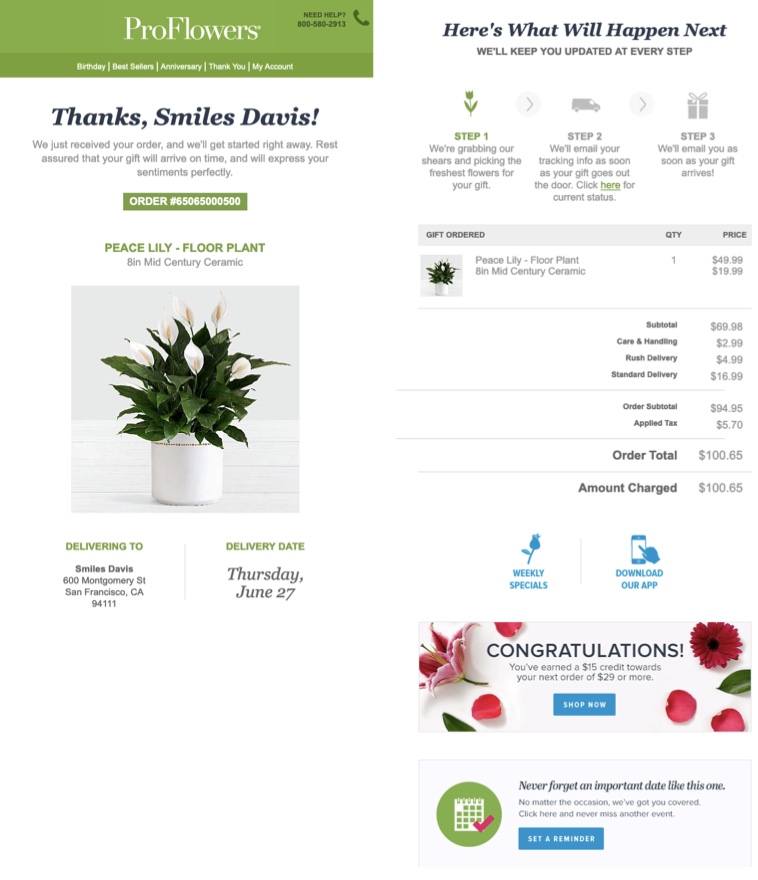
10. Order and shipping status emails
People want to know what is going on with their order and when they will receive it. Order and delivery status emails are an excellent opportunity to not only satisfy their curiosity but also to remind them of your company.
During the delivery process, send brief updates. Include all relevant information, such as the order number, tracking code, delivery conditions, and your contact information. As Tradesy does in the example below, you can include discounts, gifts, or special offers for future transactions.
The unique offer is highlighted in this email by a bold orange CTA button. The “view order” button, on the other hand, is visible and looks fantastic in the email’s black and white design. The copy of the email provides all of the necessary information about the order — the arrival date, specifics, gratitude, and contact information — in a simple manner.

Aside from these types of emails, transactional emails may contain information about billing, events, password reset, and other topics. Check out our post on transactional emails for more information and samples.
Use AVADA Marketing Automation to Send All Types of Email Marketing

Looking for an email marketing tool that allows you to send all types of marketing emails? Try out AVADA Marketing Automation. This is a perfect tool for SMEs to get started with email marketing thanks to its user-friendly interface and affordability.
Final words
That’s it! I hope that this article has provided you with valuable information about the most common types of email marketing. Please feel free to leave comments below for further discussion on this topic!
New Posts

How To Set Up Google Analytics 4 For Your BigCommerce Store






